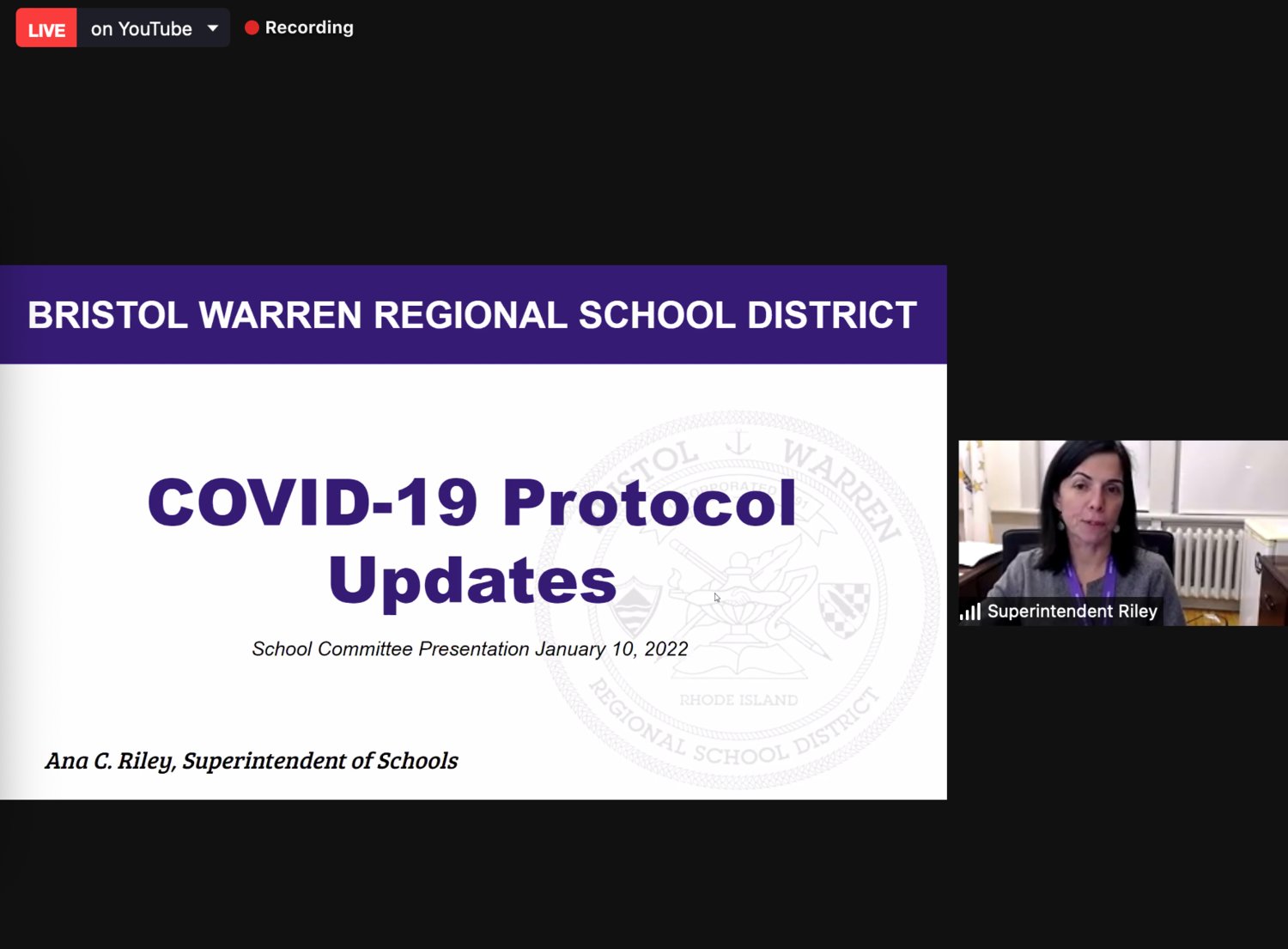Superintendent explains updated COVID protocols
Bristol Warren Superintendent Ana Riley presented updated COVID protocols to the Bristol Warren School Committee on Monday night
This item is available in full to subscribers.
Please log in to continue |
Register to post eventsIf you'd like to post an event to our calendar, you can create a free account by clicking here. Note that free accounts do not have access to our subscriber-only content. |
Day pass subscribers
Are you a day pass subscriber who needs to log in? Click here to continue.
Superintendent explains updated COVID protocols
Bristol Warren Superintendent Ana Riley presented updated COVID protocols to the Bristol Warren School Committee on Monday night, clarifying new quarantining and testing policies that have now become standardized within the district’s schools.
The key changes include the implementation of a “monitor to stay” protocol for the general student population and a “test to play” protocol for student athletes, which will hopefully enable more students to stay out of quarantine following a close contact incident with fellow students who test positive for the virus.
“That’s one of the few repeated complaints I’ve heard since I started here,” Riley said in reference to students required to go on long quarantines. “The goal is to make sure healthy students can stay in school.”
Under the new policy, all unvaccinated students will be able to remain in school following a close contact incident as long as they do not develop symptoms, and as long as the close contact incident occurred in school while other mitigating factors, such as mask wearing and social distancing, were adhered to. Vaccinated students will never have to quarantine for being a close contact unless they present symptoms or, of course, test positive themselves.
Athletes will be tested once a week for COVID, or twice a week if they are in “high risk” sports such as wrestling and hockey.
Quarantine changes, and testing remains key
If a student develops symptoms following the close contact or tests positive during voluntary testing after exposure, they will have to enter quarantine. The quarantine protocols have also been updated, and now require only five days of isolation before the student can return to class, so long as their symptoms have subsided.
One point of importance regarding the new protocols is that if a student has a close contact incident outside of school, for example with a member of their family in their home, they may be subject to a longer quarantine if they are unable to totally isolate from that family member in the home. In this case, they would have to remain in quarantine for the COVID-positive family member’s five days, and then spend an additional five days in quarantine for themselves. Hence, the maximum amount of time a student will now be faced with being quarantined out of school is 10 days.
This approach — which is based off what has been done in Connecticut since the beginning of the school year — will be bolstered by persistent testing whenever possible.
Riley made the interesting point that, since nurses should not be as heavily burdened by making calls to all close contacts’ families regardless of whether any symptoms develop, they should be more available to perform routine antigen pool testing throughout the week.
Data-driven approach
Riley said that the move to monitoring symptoms and being less stringent on quarantine protocols was backed up by data gathered by the Rhode Island Department of Health, and through observations of how Connecticut was faring under this type of protocol.
“We will continue to do this unless the Department of Health says we have an unsafe uptick in cases,” Riley said.
Riley said that the data is clear that vaccinations remain the single greatest way to prevent kids from getting sick and requiring to go into isolated quarantine. The Department of Health indicated that the vaccines are as much as 88 percent effective two to nine weeks following a dose, and dwindles in efficiency of preventing the virus to between 34 and 37 percent 15 weeks following a second dose. The vaccine efficacy jumps back to 75 percent with a booster dose, Riley said.
Riley reported that 91 percent of school cases of COVID in Rhode Island were among unvaccinated students.
“That’s why you see us continue to support vaccination clinics and provide those opportunities to our community,” Riley said.
Following another meeting with DOH, Riley said that experts in the state expect the current virus surge to last throughout January and taper off around March. She once again emphasized that schools remain the safest place for kids to be due to the consistent and stringent safety measures in place, including mask wearing, distancing, hand washing and air purifiers being located throughout buildings.
“I’m very impressed by all of our students,” Riley said. “I know it’s not the way we want to live our lives, but our kids have completely adapted.”
Remote learning options still needed
Committee Vice Chair Tara Thibaudeau asked what implementations are available to students who wind up in quarantine despite not suffering from severe effects of the virus — essentially, what learning tools are available to those who are forced to be out of school, but are still healthy enough to engage and learn?
Riley said this was an ongoing topic of discussion between administration and the teachers’ union, and at the moment, those resources amount to students interacting with documents on Google Classroom, with little or no engagement with an educator or assistance if they need it.
“We are going to work on that together to find better solutions for students who are at home through no fault of their own but are healthy enough to participate,” Riley said.






